Abstract
The pathological effects of lead on the renal, nervous, reproductive, endocrine, and immune systems have been reviewed. Emphasis is placed on reported subclinical effects due to chronic, low-level lead exposure. The crucial issue of whether subtle behavioral, intellectual, and developmental impairment occurs in young children, as a result of lead-induced CNS damage is discussed in detail. This issue remains unresolved. Further studies are needed in order to determine the long-term health effects of continuous, low-level lead exposure.
Full text
PDF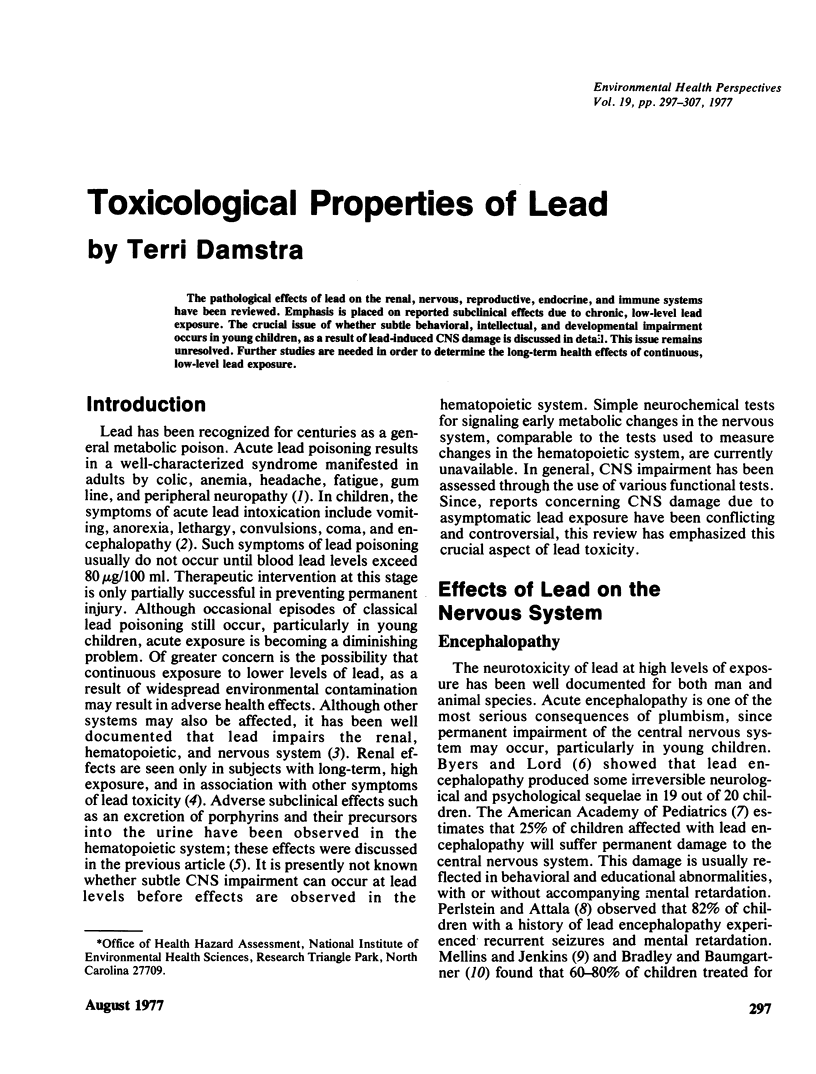
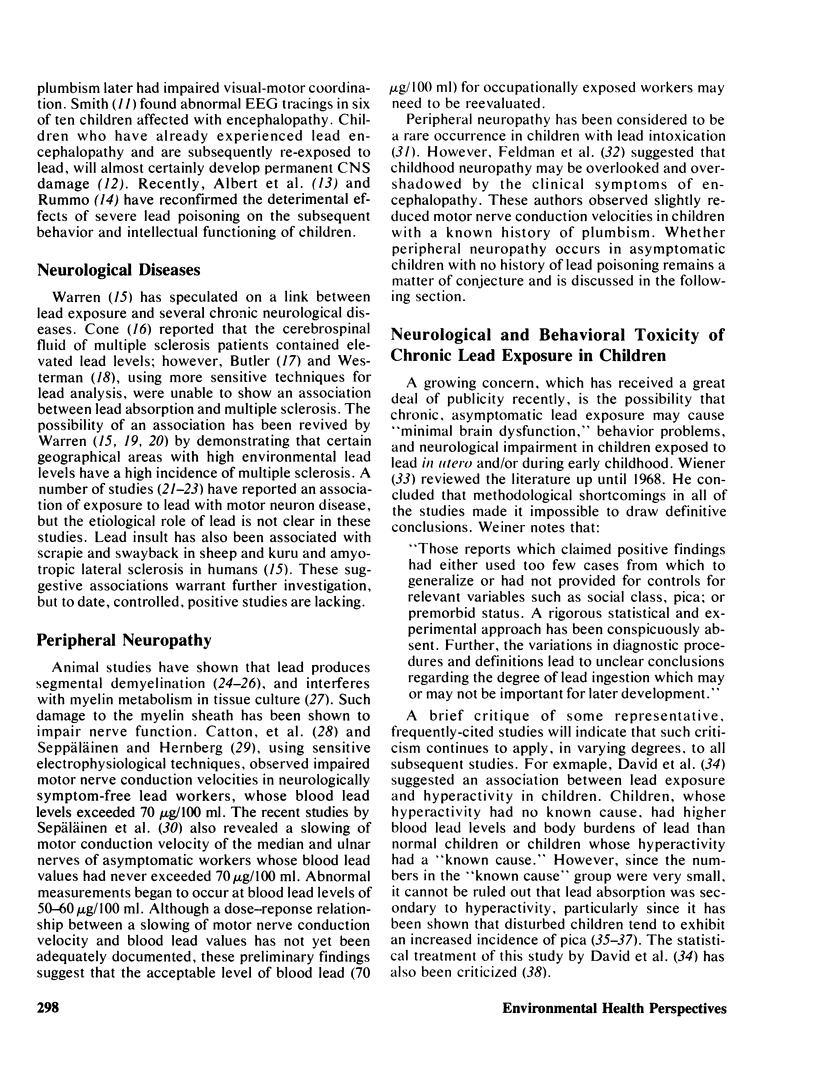
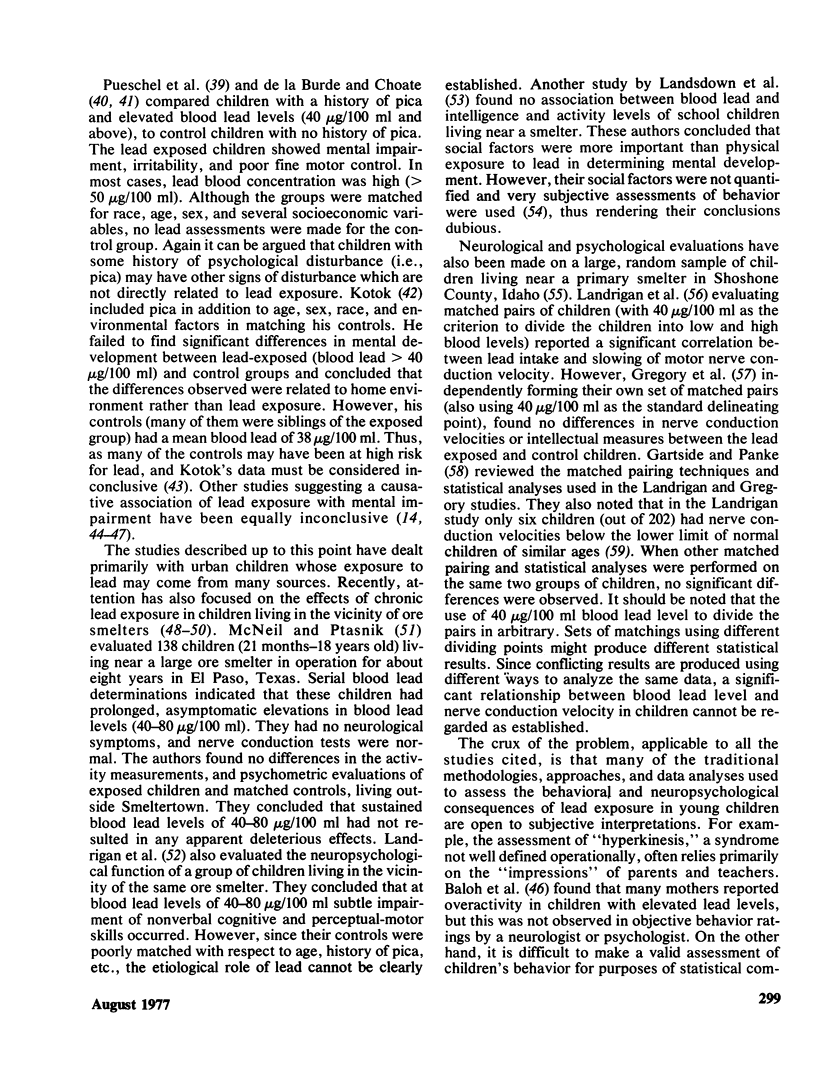
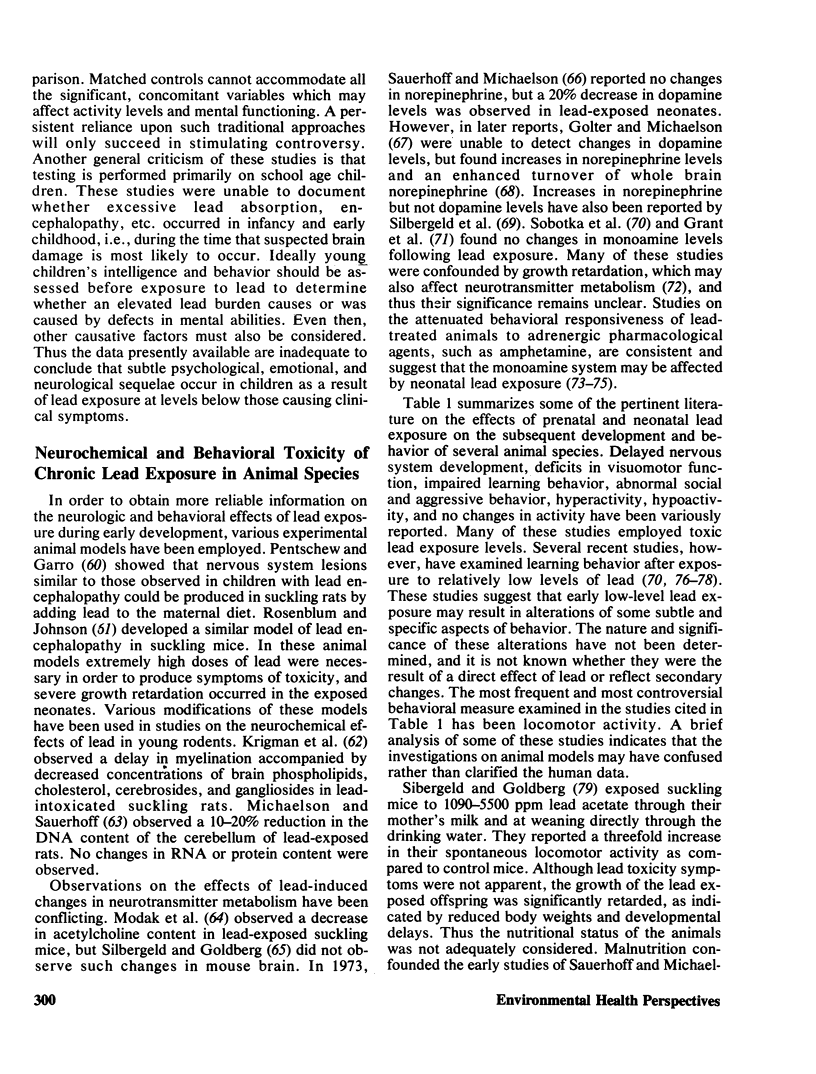
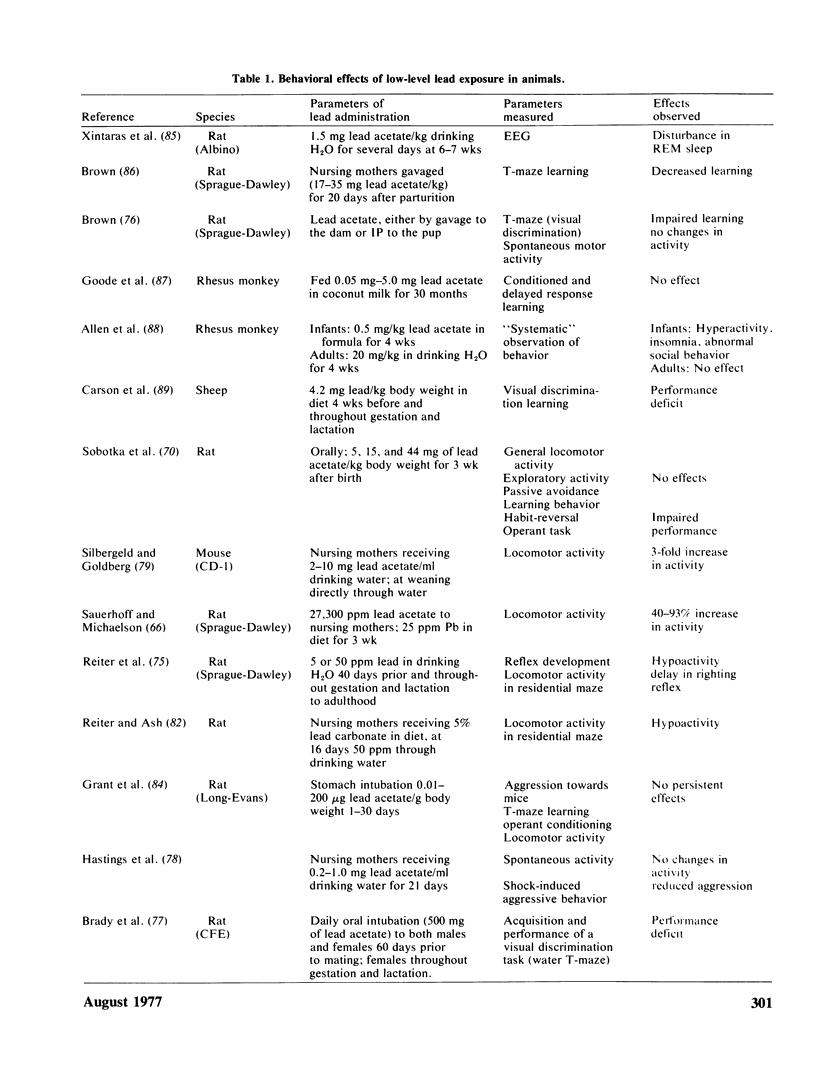
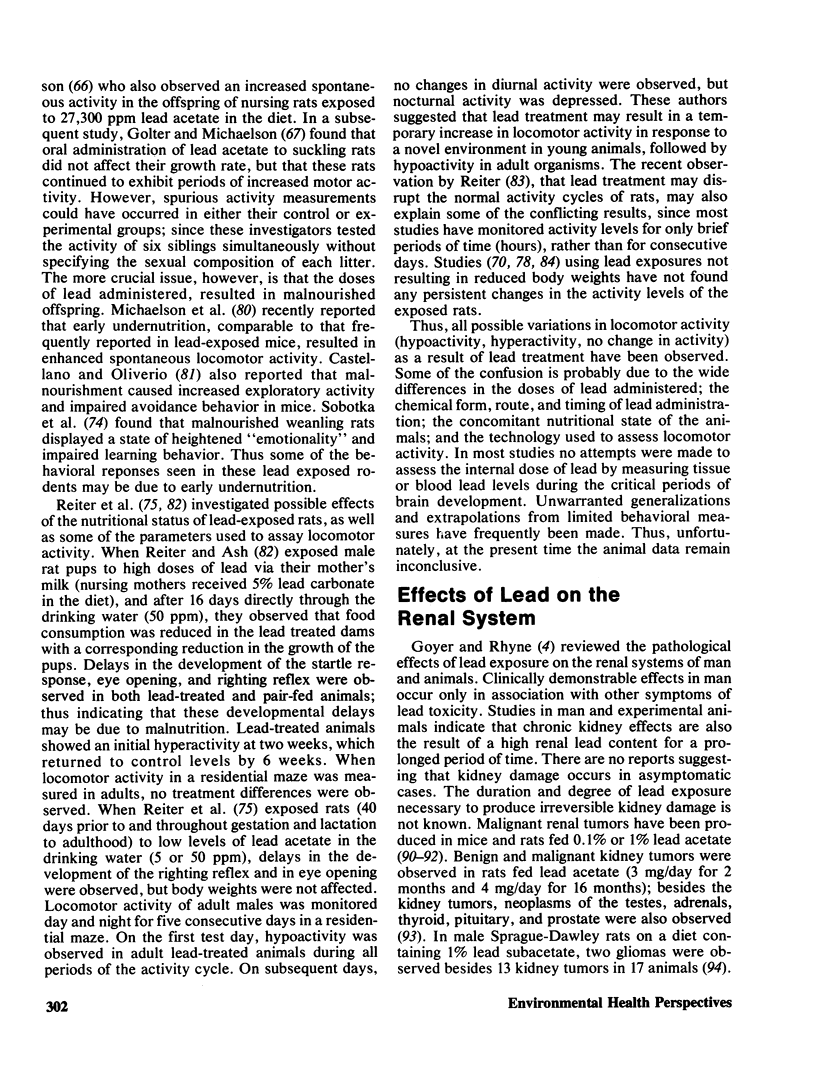
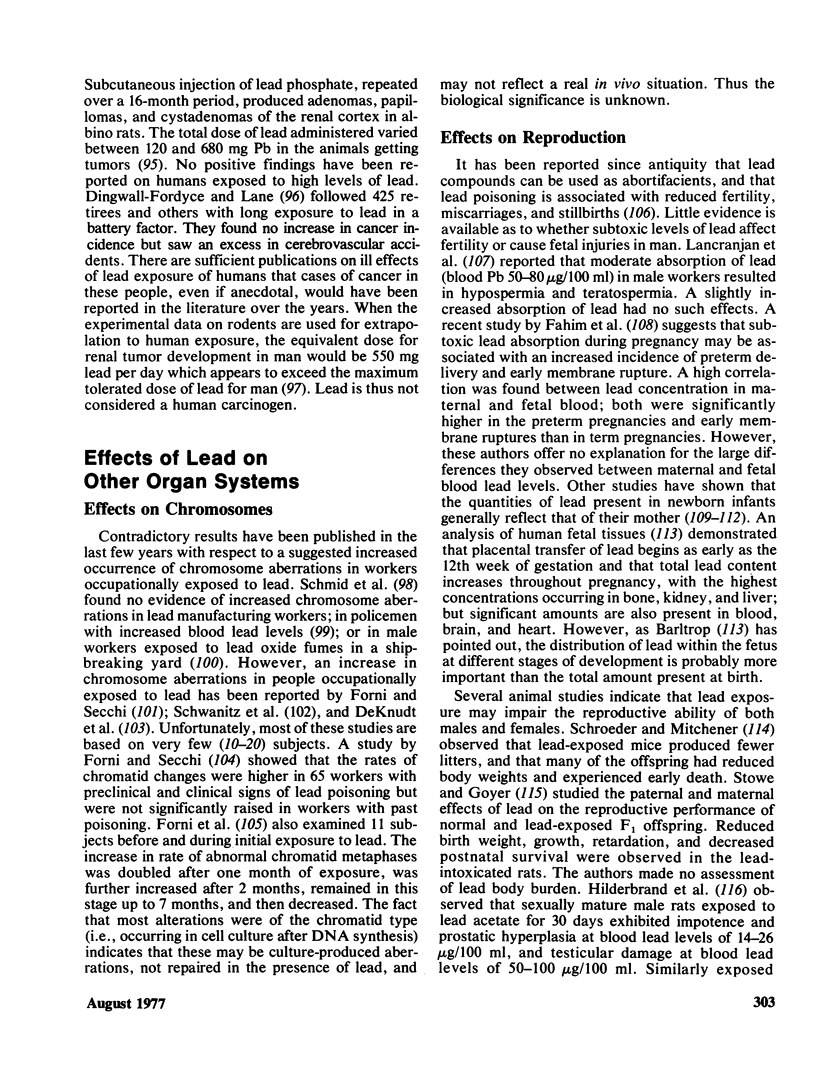
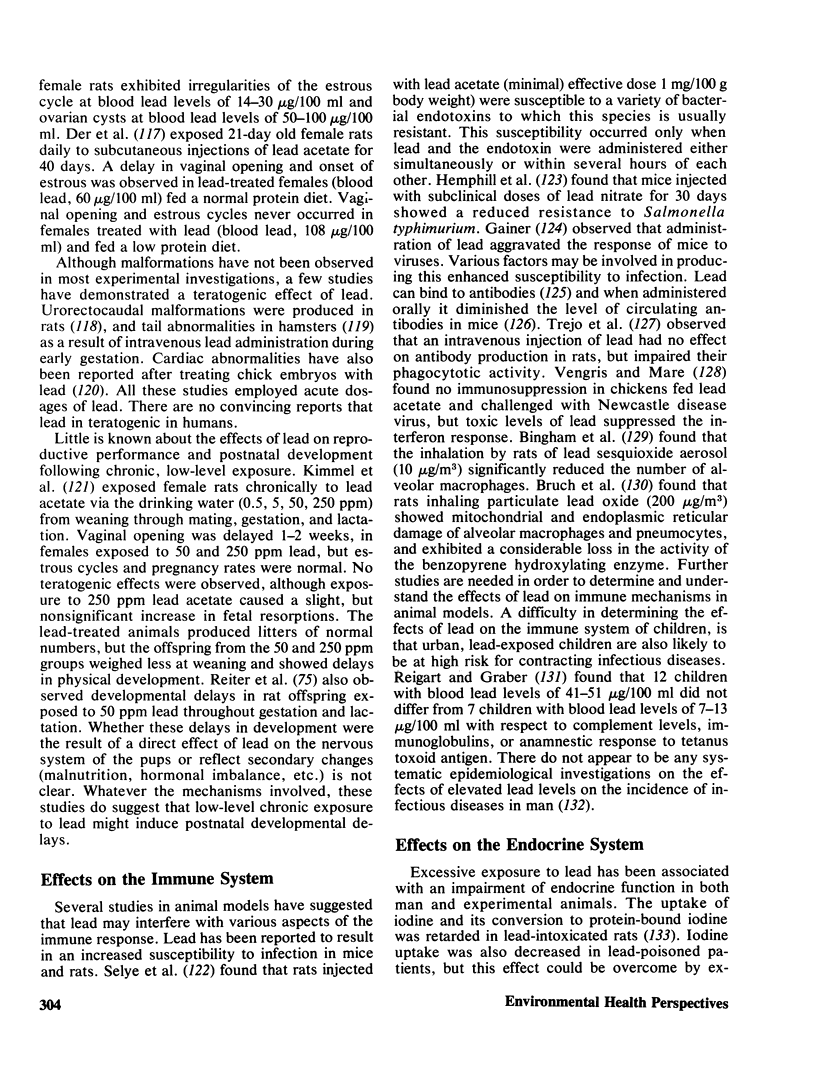
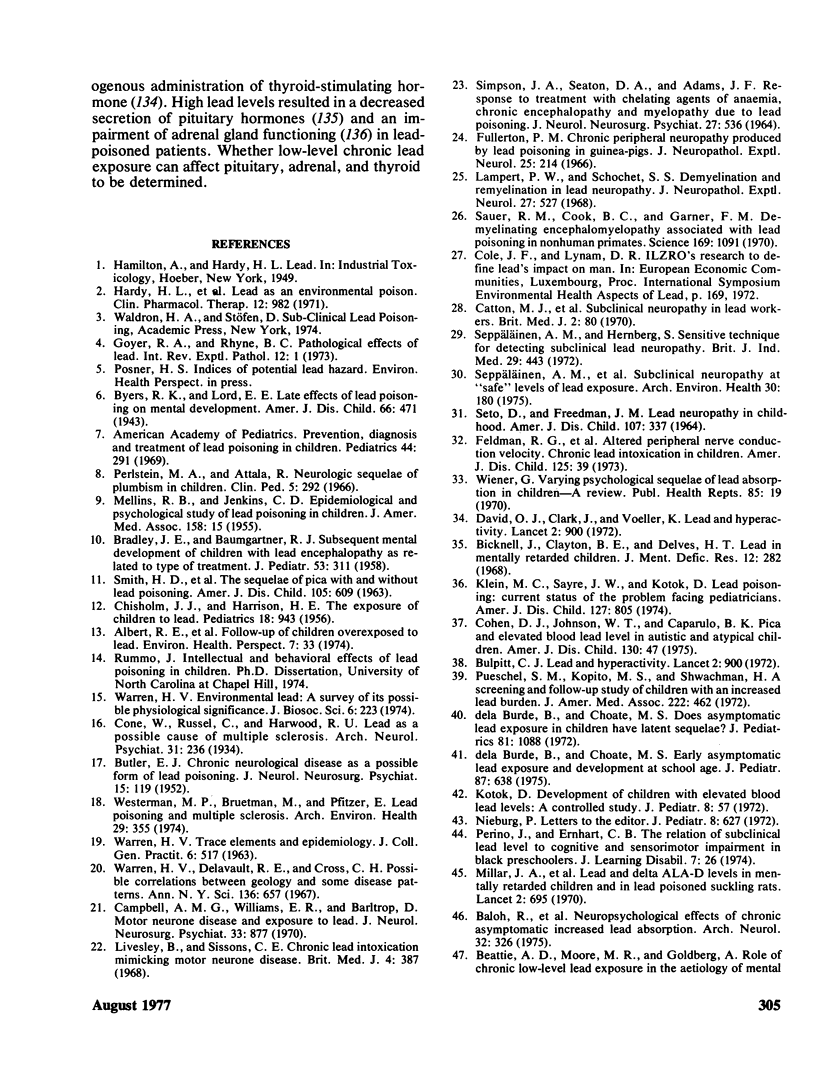
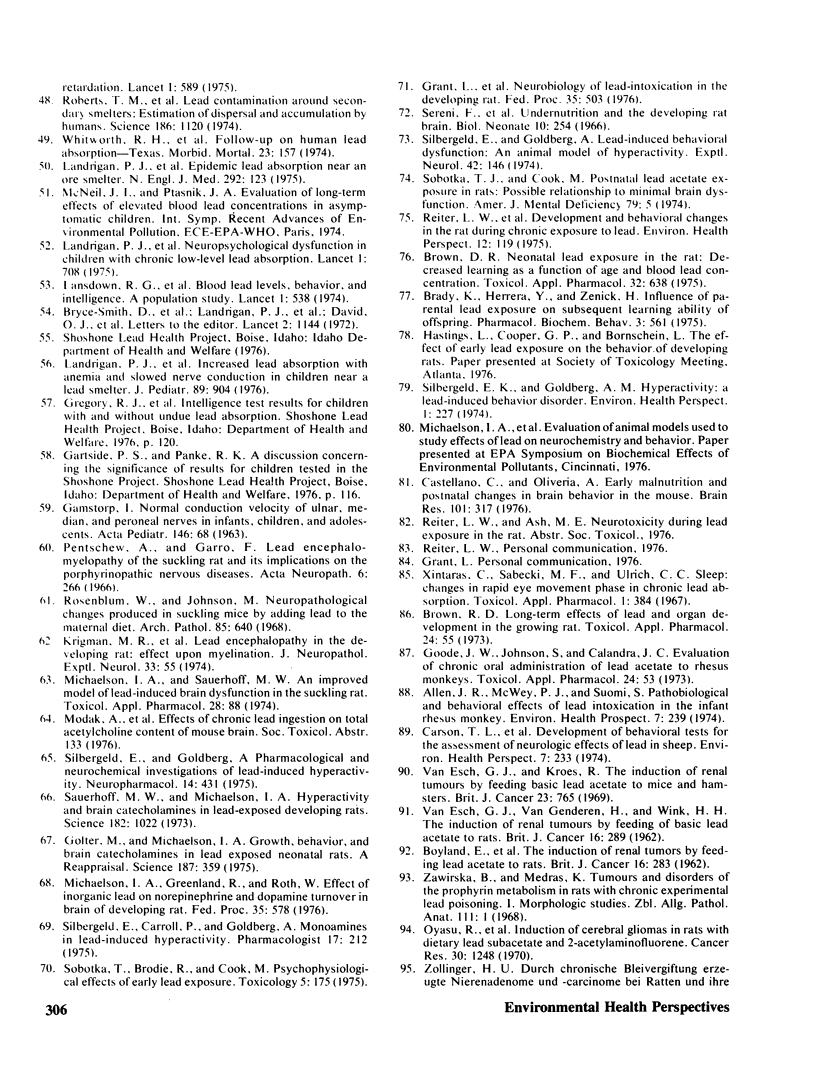
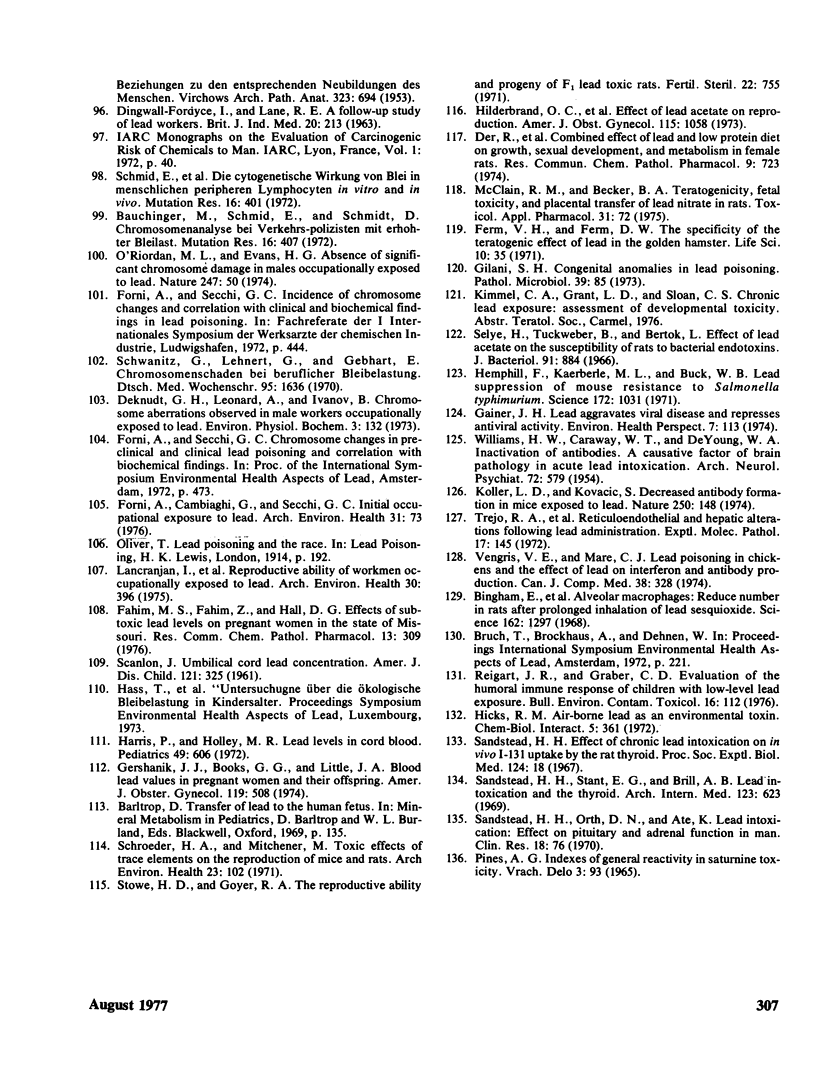
Selected References
These references are in PubMed. This may not be the complete list of references from this article.
- Albert R. E., Shore R. E., Sayers A. J., Strehlow C., Kneip T. J., Pasternack B. S., Friedhoff A. J., Covan F., Cimino J. A. Follow-up of children overexposed to lead. Environ Health Perspect. 1974 May;7:33–39. doi: 10.1289/ehp.74733. [DOI] [PMC free article] [PubMed] [Google Scholar]
- Allen J. R., McWey P. J., Suomi S. J. Pathobiological and behavioral effects of lead intoxication in the infant rhesus monkey. Environ Health Perspect. 1974 May;7:239–246. doi: 10.1289/ehp.747239. [DOI] [PMC free article] [PubMed] [Google Scholar]
- BOYLAND E., DUKES C. E., GROVER P. L., MITCHLEY B. C. The induction of renal tumors by feeding lead acetate to rats. Br J Cancer. 1962 Jun;16:283–288. doi: 10.1038/bjc.1962.33. [DOI] [PMC free article] [PubMed] [Google Scholar]
- BRADLEY J. E., BAUMGARTNER R. J. Subsequent mental development of children with lead encephalopathy, as related to type of treatment. J Pediatr. 1958 Sep;53(3):311–315. doi: 10.1016/s0022-3476(58)80217-6. [DOI] [PubMed] [Google Scholar]
- BUTLER E. J. Chronic neurological disease as a possible form of lead poisoning. J Neurol Neurosurg Psychiatry. 1952 May;15(2):119–128. doi: 10.1136/jnnp.15.2.119. [DOI] [PMC free article] [PubMed] [Google Scholar]
- Baloh R., Sturm R., Green B., Gleser G. Neuropsychological effects of chronic asymptomatic increased lead absorption. A controlled study. Arch Neurol. 1975 May;32(5):326–330. doi: 10.1001/archneur.1975.00490470070010. [DOI] [PubMed] [Google Scholar]
- Bauchinger M., Schmid E., Schmidt D. Chromosomenanalyse bei Verkehrspolizisten mit Erhöhter Bleilast. Mutat Res. 1972 Dec;16(4):407–412. doi: 10.1016/0027-5107(72)90209-6. [DOI] [PubMed] [Google Scholar]
- Bicknell J., Clayton B. E., Delves H. T. Lead in mentally retarded children. J Ment Defic Res. 1968 Dec;12(4):282–293. doi: 10.1111/j.1365-2788.1968.tb00268.x. [DOI] [PubMed] [Google Scholar]
- Bingham E., Pfitzer E. A., Barkley W., Radford E. P. Alveolar macrophages: reduced number in rats after prolonged inhalation of lead sesquioxide. Science. 1968 Dec 13;162(3859):1297–1299. doi: 10.1126/science.162.3859.1297. [DOI] [PubMed] [Google Scholar]
- Brady K., Herrera Y., Zenick H. Influence of parental lead exposure on subsequent learning ability of offspring. Pharmacol Biochem Behav. 1975 Jul-Aug;3(4):561–565. doi: 10.1016/0091-3057(75)90173-2. [DOI] [PubMed] [Google Scholar]
- CHISOLM J. J., Jr, HARRISON H. E. The exposure of children to lead. Pediatrics. 1956 Dec;18(6):943–958. [PubMed] [Google Scholar]
- Campbell A. M., Williams E. R., Barltrop D. Motor neurone disease and exposure to lead. J Neurol Neurosurg Psychiatry. 1970 Dec;33(6):877–885. doi: 10.1136/jnnp.33.6.877. [DOI] [PMC free article] [PubMed] [Google Scholar]
- Carson T. L., Van Gelder G. A., Karas G. G., Buck W. B. Development of behavioral tests for the assessment of neurologic effects of lead in sheep. Environ Health Perspect. 1974 May;7:233–237. doi: 10.1289/ehp.747233. [DOI] [PMC free article] [PubMed] [Google Scholar]
- Castellano C., Oliverio A. Early malnutrition and postnatal changes in brain and behavior in the mouse. Brain Res. 1976 Jan 16;101(2):317–325. doi: 10.1016/0006-8993(76)90272-9. [DOI] [PubMed] [Google Scholar]
- Catton M. J., Harrison M. J., Fullerton P. M., Kazantzis G. Subclinical neuropathy in lead workers. Br Med J. 1970 Apr 11;2(5701):80–82. doi: 10.1136/bmj.2.5701.80. [DOI] [PMC free article] [PubMed] [Google Scholar]
- Cohen D. J., Johnson W. T., Caparulo B. K. Pica and elevated blood lead level in autistic and atypical children. Am J Dis Child. 1976 Jan;130(1):47–48. doi: 10.1001/archpedi.1976.02120020049007. [DOI] [PubMed] [Google Scholar]
- David O., Clark J., Voeller K. Lead and hyperactivity. Lancet. 1972 Oct 28;2(7783):900–903. doi: 10.1016/s0140-6736(72)92534-2. [DOI] [PubMed] [Google Scholar]
- David O., Clark J., Voeller K. Lead and hyperactivity. Lancet. 1972 Oct 28;2(7783):900–903. doi: 10.1016/s0140-6736(72)92534-2. [DOI] [PubMed] [Google Scholar]
- De la Burdé B., Choate M. S., Jr Does asymptomatic lead exposure in children have latent sequelae? J Pediatr. 1972 Dec;81(6):1088–1091. doi: 10.1016/s0022-3476(72)80236-1. [DOI] [PubMed] [Google Scholar]
- Der R., Fahim Z., Hilderbrand D., Fahim M. Combined effect of lead and low protein diet on growth, sexual development, and metabolism in female rats. Res Commun Chem Pathol Pharmacol. 1974 Dec;9(4):723–738. [PubMed] [Google Scholar]
- Fahim M. S., Fahim Z., Hall D. G. Effects of subtoxic lead levels on pregnant women in the state of Missouri. Res Commun Chem Pathol Pharmacol. 1976 Feb;13(2):309–331. [PubMed] [Google Scholar]
- Feldman R. G., Haddow J., Kopito L., Schwachman H. Altered peripheral nerve conduction velocity. Chronic lead intoxication in children. Am J Dis Child. 1973 Jan;125(1):39–41. doi: 10.1001/archpedi.1973.04160010021005. [DOI] [PubMed] [Google Scholar]
- Ferm V. H., Ferm D. W. The specificity of the teratogenic effect of lead in the golden hamster. Life Sci II. 1971 Jan 8;10(1):35–39. doi: 10.1016/0024-3205(71)90222-0. [DOI] [PubMed] [Google Scholar]
- Fullerton P. M. Chronic peripheral neuropathy produced by lead poisoning in guinea-pigs. J Neuropathol Exp Neurol. 1966 Apr;25(2):214–236. doi: 10.1097/00005072-196604000-00003. [DOI] [PubMed] [Google Scholar]
- Gainer J. H. Lead aggravates viral disease and represses the antiviral activity of interferon inducers. Environ Health Perspect. 1974 May;7:113–119. doi: 10.1289/ehp.747113. [DOI] [PMC free article] [PubMed] [Google Scholar]
- Gilani S. H. Congenital cardiac anomalies in lead poisoning. Pathol Microbiol (Basel) 1973;39(2):85–90. doi: 10.1159/000162634. [DOI] [PubMed] [Google Scholar]
- Golter M., Michaelson I. A. Growth, behavior, and brain catecholamines in lead-exposed neonatal rats: a reappraisal. Science. 1975 Jan 31;187(4174):359–361. doi: 10.1126/science.1167426. [DOI] [PubMed] [Google Scholar]
- Goyer R. A., Rhyne B. C. Pathological effects of lead. Int Rev Exp Pathol. 1973;12:1–77. [PubMed] [Google Scholar]
- Gross S. B., Pfitzer E. A., Yeager D. W., Kehoe R. A. Lead in human tissues. Toxicol Appl Pharmacol. 1975 Jun;32(3):638–651. doi: 10.1016/0041-008x(75)90127-1. [DOI] [PubMed] [Google Scholar]
- Hardy H. L., Chamberlin R. I., Maloof C. C., Boylen G. W., Jr, Howell M. C. Lead as an environmental poison. Clin Pharmacol Ther. 1971 Nov-Dec;12(6):982–1002. doi: 10.1002/cpt1971126982. [DOI] [PubMed] [Google Scholar]
- Harris P., Holley M. R. Lead levels in cord blood. Pediatrics. 1972 Apr;49(4):606–608. [PubMed] [Google Scholar]
- Hemphill F. E., Kaeberle M. L., Buck W. B. Lead suppression of mouse resistance to Salmonella typhimurium. Science. 1971 Jun 4;172(3987):1031–1032. doi: 10.1126/science.172.3987.1031. [DOI] [PubMed] [Google Scholar]
- Hicks R. M. Air-borne lead as an environmental toxin. A review. Chem Biol Interact. 1972 Nov;5(6):361–390. doi: 10.1016/0009-2797(72)90075-0. [DOI] [PubMed] [Google Scholar]
- Hilderbrand D. C., Der R., Griffin W. T., Fahim M. S. Effect of lead acetate on reproduction. Am J Obstet Gynecol. 1973 Apr 15;115(8):1058–1065. doi: 10.1016/0002-9378(73)90554-1. [DOI] [PubMed] [Google Scholar]
- Klein M. C., Sayre J. W., Kotok D. Lead poisoning. Current status of the problem facing pediatricians. Am J Dis Child. 1974 Jun;127(6):805–807. doi: 10.1001/archpedi.1974.02110250031004. [DOI] [PubMed] [Google Scholar]
- Koller L. D., Kovacic S. Decreased antibody formation in mice exposed to lead. Nature. 1974 Jul 12;250(462):148–150. doi: 10.1038/250148a0. [DOI] [PubMed] [Google Scholar]
- Kotok D. Development of children with elevated blood lead levels: a controlled study. J Pediatr. 1972 Jan;80(1):57–61. doi: 10.1016/s0022-3476(72)80453-0. [DOI] [PubMed] [Google Scholar]
- Lampert P. W., Schochet S. S., Jr Demyelination and remyelination in lead neuropathy. Electron microscopic studies. J Neuropathol Exp Neurol. 1968 Oct;27(4):527–545. [PubMed] [Google Scholar]
- Lancranjan I., Popescu H. I., GAvănescu O., Klepsch I., Serbănescu M. Reproductive ability of workmen occupationally exposed to lead. Arch Environ Health. 1975 Aug;30(8):396–401. doi: 10.1080/00039896.1975.10666733. [DOI] [PubMed] [Google Scholar]
- Landrigan P. J., Baker E. L., Jr, Feldman R. G., Cox D. H., Eden K. V., Orenstein W. A., Mather J. A., Yankel A. J., Von Lindern I. H. Increased lead absorption with anemia and slowed nerve conduction in children near a lead smelter. J Pediatr. 1976 Dec;89(6):904–910. doi: 10.1016/s0022-3476(76)80594-x. [DOI] [PubMed] [Google Scholar]
- Landrigan P. J., Gehlbach S. H., Rosenblum B. F., Shoults J. M., Candelaria R. M., Barthel W. F., Liddle J. A., Smrek A. L., Staehling N. W., Sanders J. F. Epidemic lead absorption near an ore smelter. The role of particulate lead. N Engl J Med. 1975 Jan 16;292(3):123–129. doi: 10.1056/NEJM197501162920302. [DOI] [PubMed] [Google Scholar]
- Landrigan P. J., Whitworth R. H., Baloh R. W., Staehling N. W., Barthel W. F., Rosenblum B. F. Neuropsychological dysfunction in children with chronic low-level lead absorption. Lancet. 1975 Mar 29;1(7909):708–712. doi: 10.1016/s0140-6736(75)91627-x. [DOI] [PubMed] [Google Scholar]
- Livesley B., Sissons C. E. Chronic lead intoxication mimicking motor neurone disease. Br Med J. 1968 Nov 9;4(5627):387–388. doi: 10.1136/bmj.4.5627.387-d. [DOI] [PMC free article] [PubMed] [Google Scholar]
- MELLINS R. B., JENKINS C. D. Epidemiological and psychological study of lead poisoning in children. J Am Med Assoc. 1955 May 7;158(1):15–20. doi: 10.1001/jama.1955.02960010017004. [DOI] [PubMed] [Google Scholar]
- McClain R. M., Becker B. A. Teratogenicity, fetal toxicity, and placental transfer of lead nitrate in rats. Toxicol Appl Pharmacol. 1975 Jan;31(1):72–82. doi: 10.1016/0041-008x(75)90053-8. [DOI] [PubMed] [Google Scholar]
- Michaelson I. A., Sauerhoff M. W. An improved model of lead-induced brain dysfunction in the suckling rat. Toxicol Appl Pharmacol. 1974 Apr;28(1):88–96. doi: 10.1016/0041-008x(74)90134-3. [DOI] [PubMed] [Google Scholar]
- Millar J. A., Battistini V., Cumming R. L., Carswell F., Goldberg A. Lead and delta-aminolaevulinic acid dehydratase levels in mentally retarded children and in lead-poisoned suckling rats. Lancet. 1970 Oct 3;2(7675):695–698. doi: 10.1016/s0140-6736(70)91962-8. [DOI] [PubMed] [Google Scholar]
- O'Riordan M. L., Evans H. J. Absence of significant chromosome damage in males occupationally exposed to lead. Nature. 1974 Jan 4;247(5435):50–53. doi: 10.1038/247050a0. [DOI] [PubMed] [Google Scholar]
- Oyasu R., Battifora H. A., Clasen R. A., McDonald J. H., Hass G. M. Induction of cerebral gliomas in rats with dietary lead subacetate and 2-acetylaminofluorene. Cancer Res. 1970 May;30(5):1248–1261. [PubMed] [Google Scholar]
- Pentschew A., Garro F. Lead encephalo-myelopathy of the suckling rat and its implications on the porphyrinopathic nervous diseases. With special reference to the permeability disorders of the nervous system's capillaries. Acta Neuropathol. 1966 Jun 1;6(3):266–278. doi: 10.1007/BF00687857. [DOI] [PubMed] [Google Scholar]
- Pueschel S. M., Kopito L., Schwachman H. Children with an increased lead burden. A screening and follow-up study. JAMA. 1972 Oct;222(4):462–466. [PubMed] [Google Scholar]
- Reigart J. R., Graber C. D. Evaluation of the humoral immune response of children with low lead exposure. Bull Environ Contam Toxicol. 1976 Jul;16(1):112–117. doi: 10.1007/BF01753115. [DOI] [PubMed] [Google Scholar]
- Reiter L. W., Anderson G. E., Laskey J. W., Cahill D. F. Developmental and behavioral changes in the rat during chronic exposure to lead. Environ Health Perspect. 1975 Dec;12:119–123. doi: 10.1289/ehp.7512119. [DOI] [PMC free article] [PubMed] [Google Scholar]
- Roberts T. M., Hutchinson T. C., Paciga J., Chattopadhyay A., Jervis R. E., VanLoon J., Parkinson D. K. Lead contamination around secondary smelters: estimation of dispersal and accumulation by humans. Science. 1974 Dec 20;186(4169):1120–1123. doi: 10.1126/science.186.4169.1120. [DOI] [PubMed] [Google Scholar]
- Rosenblum W. I., Johnson M. G. Neuropathologic changes produced in suckling mice by adding lead to the maternal diet. Arch Pathol. 1968 Jun;85(6):640–648. [PubMed] [Google Scholar]
- SETO D. S., FREEMAN J. M. LEAD NEUROPATHY IN CHILDHOOD. Am J Dis Child. 1964 Apr;107:337–342. doi: 10.1001/archpedi.1964.02080060339003. [DOI] [PubMed] [Google Scholar]
- SIMPSON J. A., SEATON D. A., ADAMS J. F. RESPONSE TO TREATMENT WITH CHELATING AGENTS OF ANAEMIA, CHRONIC ENCEPHALOPATHY, AND MYELOPATHY DUE TO LEAD POISONING. J Neurol Neurosurg Psychiatry. 1964 Dec;27:536–541. doi: 10.1136/jnnp.27.6.536. [DOI] [PMC free article] [PubMed] [Google Scholar]
- SMITH H. D., BAEHNER R. L., CARNEY T., MAJORS W. J. The sequelae of pica with and without lead poisoning. A comparison of the sequelae five or more years later. I. Clinical and laboratory observations. Am J Dis Child. 1963 Jun;105:609–616. doi: 10.1001/archpedi.1963.02080040611011. [DOI] [PubMed] [Google Scholar]
- Sandstead H. H. Effect of chronic lead intoxication on in vivo I-131 uptake by the rat thyroid. Proc Soc Exp Biol Med. 1967 Jan;124(1):18–20. doi: 10.3181/00379727-124-31656. [DOI] [PubMed] [Google Scholar]
- Sauer R. M., Zook B. C., Garner F. M. Demyelinating encephalomyelopathy associated with lead poisoning in nonhuman primates. Science. 1970 Sep 11;169(3950):1091–1093. doi: 10.1126/science.169.3950.1091. [DOI] [PubMed] [Google Scholar]
- Sauerhoff M. W., Michaelson I. A. Hyperactivity and brain catecholamines in lead-exposed developing rats. Science. 1973 Dec 7;182(4116):1022–1024. doi: 10.1126/science.182.4116.1022. [DOI] [PubMed] [Google Scholar]
- Scanlon J. Umbilical cord blood lead concentration. Relationship to urban or suburban residency during gestation. Am J Dis Child. 1971 Apr;121(4):325–326. [PubMed] [Google Scholar]
- Schmid E., Bauchinger M., Pietruck S., Hall G. Die Cytogenetische Wirkung von Blei in Menschlichen peripheren Lymphocyten in vitro und in vivo. Mutat Res. 1972 Dec;16(4):401–406. doi: 10.1016/0027-5107(72)90208-4. [DOI] [PubMed] [Google Scholar]
- Schroeder H. A., Mitchener M. Toxic effects of trace elements on the reproduction of mice and rats. Arch Environ Health. 1971 Aug;23(2):102–106. doi: 10.1080/00039896.1971.10665963. [DOI] [PubMed] [Google Scholar]
- Schwanitz G., Lehnert G., Gebhart E. Chromosomenschäden bei beruflicher Bleibelastung. Dtsch Med Wochenschr. 1970 Aug 7;95(32):1636–1641. doi: 10.1055/s-0028-1108701. [DOI] [PubMed] [Google Scholar]
- Selye H., Tuchweber B., Bertók L. Effect of lead acetate on the susceptibility of rats to bacterial endotoxins. J Bacteriol. 1966 Feb;91(2):884–890. doi: 10.1128/jb.91.2.884-890.1966. [DOI] [PMC free article] [PubMed] [Google Scholar]
- Seppäläinen A. M., Hernberg S. Sensitive technique for detecting subclinical lead neuropathy. Br J Ind Med. 1972 Oct;29(4):443–449. doi: 10.1136/oem.29.4.443. [DOI] [PMC free article] [PubMed] [Google Scholar]
- Seppäläinen A. M., Tola S., Hernberg S., Kock B. Subclinical neuropathy at "safe" levels of lead exposure. Arch Environ Health. 1975 Apr;30(4):180–183. doi: 10.1080/00039896.1975.10666672. [DOI] [PubMed] [Google Scholar]
- Sereni F., Principi N., Perletti L., Piceni Sereni L. Undernutrition and the developing rat brain. I. Influence on acetylcholinesterase and succinic acid dehydrogenase activities and on norepinephrine and 5-OH-tryptamine tissue concentrations. Biol Neonat. 1966;10(5):254–265. [PubMed] [Google Scholar]
- Silbergeld E. K., Goldberg A. M. Lead-induced behavioral dysfunction: an animal model of hyperactivity. Exp Neurol. 1974 Jan;42(1):146–157. doi: 10.1016/0014-4886(74)90013-2. [DOI] [PubMed] [Google Scholar]
- Silbergeld E. K., Goldberg A. M. Pharmacological and neurochemical investigations of lead-induced hyperactivity. Neuropharmacology. 1975 May-Jun;14(5-6):431–444. doi: 10.1016/0028-3908(75)90026-x. [DOI] [PubMed] [Google Scholar]
- Sobotka T. J., Brodie R. E., Cook M. P. Psychophysiologic effects of early lead exposure. Toxicology. 1975 Nov;5(2):175–191. doi: 10.1016/0300-483x(75)90115-8. [DOI] [PubMed] [Google Scholar]
- Stowe H. D., Goyer R. A. Reproductive ability and progeny of F 1 lead-toxic rats. Fertil Steril. 1971 Nov;22(11):755–760. [PubMed] [Google Scholar]
- Trejo R. A., Di Luzio N. R., Loose L. D., Hoffman E. Reticuloendothelial and hepatic functional alterations following lead acetate administration. Exp Mol Pathol. 1972 Oct;17(2):145–158. doi: 10.1016/0014-4800(72)90064-0. [DOI] [PubMed] [Google Scholar]
- Van Esch G. J., Kroes R. The induction of renal tumours by feeding basic lead acetate to mice and hamsters. Br J Cancer. 1969 Dec;23(4):765–771. doi: 10.1038/bjc.1969.95. [DOI] [PMC free article] [PubMed] [Google Scholar]
- Vengris V. E., Maré C. J. Lead poisoning in chickens and the effect of lead on interferon and antibody production. Can J Comp Med. 1974 Jul;38(3):328–335. [PMC free article] [PubMed] [Google Scholar]
- WARREN H. V. TRACE ELEMENTS AND EPIDEMIOLOGY. J Coll Gen Pract. 1963 Nov;6:517–531. [PMC free article] [PubMed] [Google Scholar]
- WILLIAMS H. W., CARAWAY W. T., DE YOUNG W. A. Inactivation of antibodies, a causative factor of brain pathology in acute lead intoxication. AMA Arch Neurol Psychiatry. 1954 Nov;72(5):579–582. [PubMed] [Google Scholar]
- Warren H. V. Proceedings: Environmental lead: a survey of its possible physiological significance. J Biosoc Sci. 1974 Apr;6(2):223–238. [PubMed] [Google Scholar]
- Westerman M. P., Bruetman M., Pfitzer E. Lead poisoning and multiple sclerosis. Arch Environ Health. 1974 Dec;29(6):355–356. doi: 10.1080/00039896.1974.10666615. [DOI] [PubMed] [Google Scholar]
- Wiener G. Varying psychological sequelae of lead ingestion in children. Public Health Rep. 1970 Jan;85(1):19–24. [PMC free article] [PubMed] [Google Scholar]
- ZOLLINGER H. U. Durch chronische Bleivergiftung erzeugte Nierenadenome und -carcinome bei Ratten und ihre Beziehungen zu den entsprechenden Neubildungen des Menschen. Virchows Arch Pathol Anat Physiol Klin Med. 1953;323(6):694–710. doi: 10.1007/BF00956266. [DOI] [PubMed] [Google Scholar]
- de la Burdé B., Choate M. L. Early asymptomatic lead exposure and development at school age. J Pediatr. 1975 Oct;87(4):638–642. doi: 10.1016/s0022-3476(75)80845-6. [DOI] [PubMed] [Google Scholar]
- van ESCH G., van GENDEREN, VINK H. H. The induction of renal tumours by feeding of basic lead acetate to rats. Br J Cancer. 1962 Jun;16:289–297. doi: 10.1038/bjc.1962.34. [DOI] [PMC free article] [PubMed] [Google Scholar]


